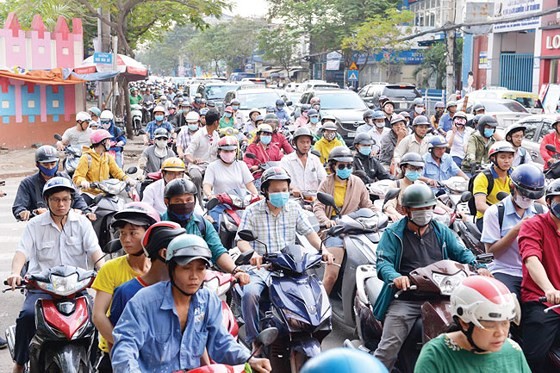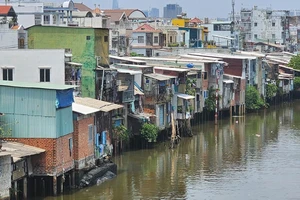
They were speaking at a conference hosted by the HCMC Committee of the Vietnam Fatherland Front to get social feedback on the project.
Reporting at the conference, the HCMC Department of Transport and Transport Development and Strategy Institute (TDSI) quoted survey results in residential areas saying that 62.56 percent of respondents said that it is needed to limit cars and motorbikes.
In addition, some agreed with solutions such as working and school time changes, charging fee on cars in downtown area, IT application in traffic management including automatic toll collection and penalty.
According to the institute, the number of vehicles continues increasing far beyond the city’s capacity with 8-8.5 millions of motorbikes and 300,000-350,000 cars. Admid that scenario, public transport considered as one of determinants limiting private vehicles has been in downward trend. The current bus network is unreasonable and not developed appropriately with transport output continuously dropping and meeting only 4.3 percent of urban transport demand.
The solution of private motorbike limitation put forward by the institute is short term for the center area of HCMC. It will be expanded to Districts 1, 3, 5, 10, Thu Thiem new urban area and Phu My Hung new urban area by 2030 and neighboring areas afterwards.
Associate professor and Dr. Pham Thi Hong Xuan from HCMC University of Social Sciences and Humanities said that the survey by the institute has not referred to transport capacity and travel demand in coming years. Solutions do not include factors such as age, gender and residential psychology.
Lawyer Nguyen Van Hau from HCMC Bar Association concerned about the solution of banning motorbikes from travelling in center areas from 2025-2030. During such a short time with the traffic infrastructure and substitute ability of public transport means at the moment and in the next few years, the solution is unlikely to be feasible.
Mr. Hau said that the ban applied for all people including those living in areas with limited public transport system will push difficulty toward residents. Aside from that, the ban might cause many new traffic congestion spots with the forming of huge parking lots in areas adjacent to the center area of HCMC.
From another angle, the ban will affect residents’ rights because the constitution stipulates that residents’ rights are just restricted in some cases related to public order, he added.
Building high power public transport system
Dr Nguyen Minh Hoa said that solutions on replacing private vehicles was unpractical while lot of motorbike and car makers are marketing their products. The number of motorbikes and automobiles are over eight million and 400,000 respectively now. The numbers will quickly increase in the next couple of years. At that time both ban or limitation solutions will be unable to solve the issue.
Sharing the same view, Dr. Huynh The Du from Fullbright Vietnam University, said that reducing motorbikes will send residents to use individual cars and traffic jam will worsen. Banning motorbikes by 2025 without public transport substitute will just result in new congestion spots. Hence the pressing solution is to develop high capacitiy public transport system, he suggested.
Architect Khuong Van Muoi said that the city has issued a traffic plan for many years but implementation solutions have been asynchronous. The plan refers to the suitability of urban area development in association with traffic development counting small buses operating in areas adjacent to the center area, still that has not been materialized.
Dr. Nguyen Cao Tri from Van Lang University proposed to reconsider the bus fare subsidy policy which has been carried out inefficiently for the last many years. HCMC spends nearly VND2 trillion (US$86.19 million) on the program annually while the number of bus commuters totals only few hundreds of people, so it is too wasteful. The huge amount of money should be invested in developing public transport means, he suggested.
Engineer Tran Dinh Tu proposed to look into the suitability of planning. HCMC has over ten million residents with a shortage of satellite cities but plans have focused too much on financial center, banks, trade, tourism, traffic and urban aspects. The deviatory plan has caused urban traffic chaos. As a result, the city has fumbled about solutions but been unable to solve traffic jam, he said.
























